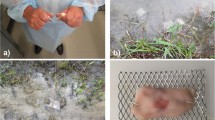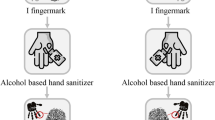Abstract
Trace DNA is a significant type of evidence for its ability to be collected from touched items or surfaces at crime scenes to link suspects to their crimes. In cases of violent crimes like assault, sexual offences, or even homicide, often touch DNA is collected from the victim’s skin. However, the collection of touch DNA from the victim’s skin can be complex because of the mixture of DNA present, as there is likely to be a small quantity of the offender’s DNA compared to the victim’s DNA. Validating different collection methods or techniques can improve touch DNA sampling; therefore, this study investigated three collection techniques involving cotton and nylon swabs to test their efficiency for the collection of touch DNA from the human neck. There was a significant difference between the three recovery techniques used to recover touch DNA with a cotton swab (CS) (p < 0.05) and nylon swab (NS) (p < 0.05), with more alleles observed when the neck skin was moistened with 100 μL of distilled water using a spray bottle before collection with both swabs.




Similar content being viewed by others
Data availability
Not applicable.
References
Alketbi SK (2018) The affecting factors of touch DNA. J Forensic Res 9:424
Alketbi SK, Goodwin W (2019) The effect of surface type, collection, and extraction methods on touch DNA. Forensic Sci Int Genet Suppl Series 7(1):704–706
Alketbi SK, Goodwin W (2019) The effect of time and environmental conditions on touch DNA. Forensic Sci Int Genet Suppl Ser 7(1):701–703
Kallupurackal V et al (2021) Sampling touch DNA from human skin following skin-to-skin contact in mock assault scenarios—a comparison of nine collection methods. J Forensic Sci 66(5):1889–1900
de Bruin KG et al (2011) Comparison of stubbing and the double swab method for collecting offender epithelial material from a victim’s skin. Forensic Sci Int Genet 6(2):219–223
Alketbi SK, Goodwin W (2022) The impact of area size and fabric type on touch DNA collected from fabric. J Forensic Sci Crim Investig 16(1):555926
Alketbi SK, Goodwin W (2022) The impact of deposition area and time on touch DNA collected from fabric. Forensic Sc Int Genet Suppl Ser 8(1):45–47
Alketbi SK (2022) The impact of collection method on touch DNA collected from fabric. J Forensic Sci Crim Investig 15(5):555922
Wallace L, Merritt R, Carney C (2007) Collection and analysis of touch DNA deposited on skin. J Forensic Sci 52(1):1–7
Oldroyd NJ, Watson SK, Miller K (2017) Collection and analysis of touch DNA: a practical guide. Forensic Sci Int: Genet Suppl Ser 6:e595–e596
Jang CG, Park JH, Lee HC (2015) Comparison of two swabbing methods for the recovery of touch DNA from human skin. Forensic Sci Int Genet 14:247–252
Hogan C, Oldroyd N, Miller K (2019) Comparison of two methods for the collection of touch DNA from human skin. Forensic Sci Int: Genet Suppl Ser 7(1):49–50
Alketbi SK (2022) An innovative solution to collect Touch DNA for direct amplification. J Forensic Sci Crim Investig 16(1):555928
Chong EK, Chan KL (2017) Direct PCR amplification of touch DNA from human skin. Forensic Sci Int: Genet Suppl Ser 6:e533–e535
Alketbi SK, Goodwin W (2023) Collection methods for touch DNA direct amplification. J Forensic Leg Invest Sci 9:072
Alketbi SK (2023) Analysis of touch DNA. Doctoral thesis, University of Central Lancashire. Available at https://clok.uclan.ac.uk/46154/
Gouveia N, Brito P, Serra A, Balsa F, Andrade L, Bento MS, Cunha P, Bogas V, Lopes V, Porto MJ (2015) Direct amplification of reference samples with Globalfiler® PCR Amplification Kit. Forensic Sci Int: Genet Suppl Ser 5:e135–e137
Ambers A, Wiley R, Novroski N, Budowle B (2018) Direct PCR amplification of DNA from human bloodstains, saliva, and touch samples collected with microFLOQ® swabs. Forensic Sci Int Genet 32:80–87
De Jong WK, Kleibeuker KH (2019) The forensic potential of touch DNA on human skin. Forensic Sci Int: Genet Suppl Ser 7(1):31–33
Alketbi SK, Goodwin W (2019) Validating touch DNA collection techniques using cotton swabs. J Forensic Res 10:445
Alketbi SK, Goodwin W (2021) Touch DNA collection techniques for non-porous surfaces using cotton and nylon swabs. Biomed J Sci Tech Res 36(3):28608–28612
Alketbi SK, Goodwin W (2019) The effect of sandy surfaces on touch DNA. J Forensic Leg Invest Sci 5:034
Dadhania A, Nelson M, Caves G, Santiago R, Podini D (2013) Evaluation of Copan 4N6FLOQSwabs™ used for crime scene evidence collection. Forensic Sci Int Genet Suppl Series 4(1):336–337
Ruff P, Holtkötter H (2017) Forensic investigation of trace DNA from human skin. Forensic Sci Int: Genet Suppl Ser 6:e415–e417
Alketbi SK (2023) Maintaining the chain of custody: anti-contamination measures for trace DNA evidence. Int J Sci Res Arch 08(02):457–461
Sijen T (2015) Touch DNA evidence: from crime scene to court. Hum Genet 134(3):259–271
Van den Berge M, Bhoelai B, Harteveld J, Matai A (2019) Touch DNA recovery from human skin. Forensic Sci Int: Genet Suppl Ser 7(1):52–53
Bleka Ø, Haugum M, Gill P (2014) A comparison of DNA profiles produced from automated and manual extraction from human skin and contact DNA samples. Forensic Sci Int Genet 9:29–34
De Rijke B, Westen AV (2021) Touch DNA analysis on human skin: method comparison for swabbing and extraction. Forensic Sci Int Genet 53:102497
Author information
Authors and Affiliations
Corresponding author
Ethics declarations
Ethical approval
This study was approved by the General Department of Forensic Science and Criminology in Dubai Police and ethical approval was granted by the School of Forensic and Applied Sciences, and the University of Central Lancashire’s Research Ethics Committee (ref. no. STEMH 912).
Informed consent
Not applicable.
Research involving human participants and/or animals
Not applicable.
Conflict of interest
The author declares no competing interests.
Additional information
Publisher's note
Springer Nature remains neutral with regard to jurisdictional claims in published maps and institutional affiliations.
Key Points
• In scenarios of vicious crimes like assault, sexual offences, or even homicide, trace DNA can be recovered from the skin of the victim.
• This study investigated three collection techniques involving cotton and nylon swabs to examine their efficiency for the collection of trace DNA from the human neck following a strangulation scenario.
• There was a significant difference between the three recovery techniques used to recover touch DNA with a cotton swab (p < 0.05) and nylon swab (p < 0.05), with more alleles observed when the neck skin was moistened with 100 μL of distilled water using a spray bottle before collection for both swabs.
Rights and permissions
Springer Nature or its licensor (e.g. a society or other partner) holds exclusive rights to this article under a publishing agreement with the author(s) or other rightsholder(s); author self-archiving of the accepted manuscript version of this article is solely governed by the terms of such publishing agreement and applicable law.
About this article
Cite this article
Alketbi, S.K. Collection techniques of touch DNA deposited on human skin following a strangulation scenario. Int J Legal Med 137, 1347–1352 (2023). https://doi.org/10.1007/s00414-023-03036-8
Received:
Accepted:
Published:
Issue Date:
DOI: https://doi.org/10.1007/s00414-023-03036-8




